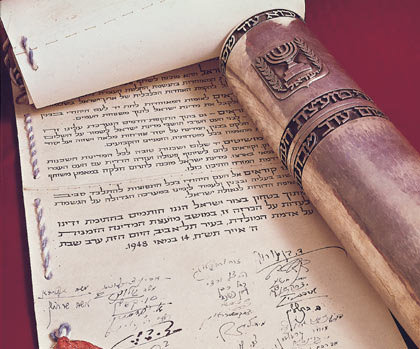Israel's Declaration of Independence - The document that turned a dream into reality

“The Land of Israel was the birthplace of the Jewish people. Here their spiritual, religious and political identity was shaped…”
On May 14, 1948, the modern State of Israel was declared by David Ben-Gurion as he read out, for the first time, the Jewish state's Declaration of Independence in the city of Tel Aviv.
Thus the prophetic words written 46 years earlier by the founder of Zionism, Theodore Herzl, became reality: "If you will it, it is no dream."
After the United Nations General Assembly on Nov. 29, 1947 adopted Resolution 181 (II), the partition plan that had created the basis for the Israeli state, the British mandate, which until that day had controlled the area of modern-day Israel, expired at midnight between May 14 and 15.
With the mandate scheduled to expire soon, the Jewish National Council, the governing body of the Yishuv, the Jewish community, began to prepare for statehood. Together, they organized a government and formed the Moetzet HaAm, a provisional state council responsible for creating a declaration of independence for the new state.
What’s in the declaration?
After the wording of Israel's Declaration of Independence was drafted and edited by multiple committees, Moetzet HaAm approved the final version, just a mere hour before the official declaration.

The text begins by recapitulating the history of the Jewish people, emphasizing its close and continuous connection to the land of Israel, as well as mentioning Zionism and the Holocaust before declaring: “The establishment of a Jewish state in Eretz-Yisrael, to be known as the State of Israel.”
It continues by calling on the UN and on Jews worldwide for assistance, and states that Israel extends a “hand to all neighboring states… in an offer of peace.”
A major contentious issue regarding the text was the question if God should be mentioned. Two Rabbis supported including the phrase “God of Israel” or “Redeemer of Israel” in the document’s closing paragraphs.
The leftist socialist members opposed this, however, and a compromise was ultimately reached to use the phrase “Rock of Israel,” which can be interpreted as either referring to God, or the land of Israel.
Where was the declaration read for the first time?
The declaration ceremony was held in the hall of a museum, which today is called Independence Hall, and serves as a museum dedicated to the remembrance of this momentous event. Most Israeli grade school students will visit this place at least once.
At 4 p.m. on May 14, 1948, Ben-Gurion stood up, banged his gavel on the table, read the declaration and then asked a Rabbi to recite a blessing; thus the State of Israel was born.
As leader of the Yishuv, David Ben-Gurion was the first to sign the Declaration of Independence, followed by the 25 present members of the Moetzet HaAm who signed in alphabetical order.
What is the legal status of Israel's Declaration of Independence?
This question continues to be relevant in the State of Israel, as it never established a constitution. The declaration thus remains the central founding document of the state but is neither a law nor a binding legal document.
Many of Israel’s current laws touching on human rights are directly inspired by passages of the Declaration, for example, “[Israel] will ensure complete equality of social and political rights to all its inhabitants irrespective of religion, race or sex; it will guarantee freedom of religion, conscience, language, education and culture…”
The Declaration of Independence continues to be very present in Israeli life, as pictures of the declaration scroll can be found in every classroom in Israel.
It also serves as an inspiration and a point of contention in modern-day politics, as was clearly seen during the anti-judicial reform protests of 2023.
Israel’s Declaration of Independence is our country’s founding document, establishing our commitment to democracy and equal protection for all citizens.
— Mayor of Tel Aviv (@MayorOfTelAviv) December 12, 2022
Today, @TelAviv City Hall hangs it for all to see, reminding our society and leaders that we will always stand by our values. pic.twitter.com/JuiNTlEut9
One of the protest movement’s most popular slogans has been “Loyal to the Declaration of Independence,” with posters of the declaration seemingly plastered everywhere, including on protest props like stolen memorial tanks and even on the side of Tel Aviv’s Municipality building.

The All Israel News Staff is a team of journalists in Israel.
You might also like to read this:
















